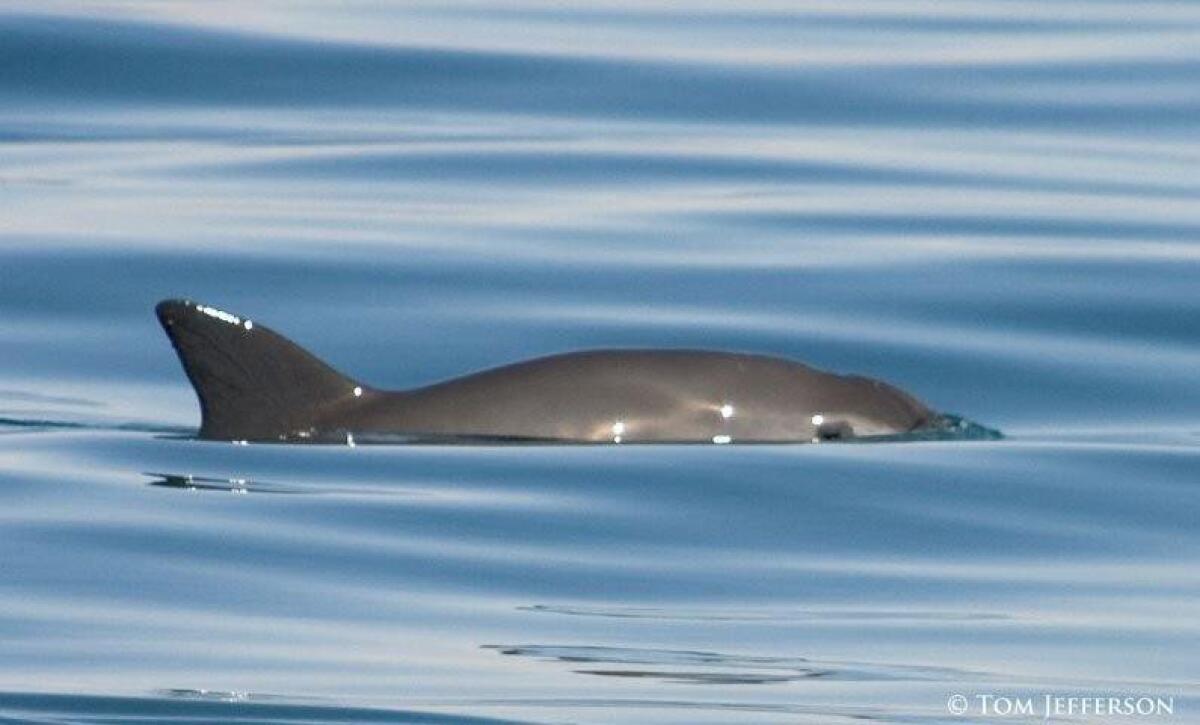Only 60 vaquita porpoises are left in Gulf of California, and gill-net fishing is to blame, experts say

The population of the vaquita, a small porpoise endemic to Mexico’s upper Gulf of California, has plummeted to about 60 survivors, according to a new study by an international team of scientists that urges stronger measures to protect the species.
Without sustained efforts, scientists warn that the vaquita, the world’s most endangered marine mammal, could become extinct within five years.
Their report was presented in Ensenada this week to Mexico’s secretary of the environment and natural resources, Rafael Pacchiano Alamán. It urges a permanent ban on the drift gill nets used by fishermen in the upper Gulf, as well as stronger enforcement measures to prevent illegal fishing.
While praising “unprecedented conservation actions” to protect the vaquita, scientists say the porpoises continue to drown when they end up unintentionally caught in the nets used to catch another critically endangered species, totoaba fish, whose air bladders command high prices in China.
In March alone, three dead vaquita were found, “all having died from entanglement in gill nets probably set for totoaba,” according to a statement sent late Friday.
The authors of the report are members of the International Committee for the Recovery of the Vaquita (CIRVA), an international advisory group to the Mexican government. Their findings come more than a year after President Enrique Peña Nieto traveled to the Baja California fishing town of San Felipe to announce an unprecedented two-year ban on gill-net fishing in the vaquita habitat and a compensation program for local fishermen.
“We are watching this precious native species disappear before our eyes,” Lorenzo Rojas-Bracho, CIRVA’S chairman, said in the statement. “The gill net ban and strong enforcement must continue if we are to have any hope of saving the vaquita,” said Rojas-Bracho, who is coordinator of research and marine mammal conservation at Mexico’s National Institute for Ecology and Climate Change.
Rojas-Bracho was co-chief scientist during a nine-week expedition in the upper Gulf last fall commissioned by the Mexican government to determine the number of vaquita remaining. Observers spent hours each day behind high-powered binoculars aboard the research vessel Ocean Starr, scouring the surface for signs of the vaquita, which must surface to breathe. Their findings in deeper waters where the ship could navigate were combined with acoustic data in shallow waters that registered high-frequency clicks that vaquita use to locate their prey.
See more of our top stories on Facebook >>
After months of processing the information, the final result showed that the numbers have continued their downward trend of recent years, from 567 in 1997 to 245 in 2008 to about 60 in 2015.
“We would be in much worse shape if they hadn’t taken the emergency ban,” said Barbara Taylor, a conservation biologist at the National Oceanic and Atmospheric Administration’s Southwest Fisheries Science Center in La Jolla and co-chief scientist in the vaquita survey. If gill-netting is allowed to resume in the upper Gulf, the vaquita could be extinct by 2022, she said.
Pacchiano, the environmental secretary, said federal law enforcement agencies have been collaborating to prevent illegal totoaba fishing in the upper Gulf, as well as fighting the illegal trafficking of the species and the “presence of organized criminal groups related to this activity.” In a statement, he also stressed the importance of increasing protective measures.
Despite the dwindling number of vaquita, which grow to about five feet and 120 pounds, Taylor and other scientists say that the species is not beyond salvation. But it will require political will and economic resources. One measure they recommend is closing a loophole that allows the seasonal fishing of Gulf corvina, a practice that can be a cover for clandestine totoaba fishing.
The Mexican government’s progress is being closely watched by the international environmental community. One organization, the Sea Shepherd Conservation Society, has sent two ships to the upper Gulf to collaborate with Mexican law enforcement agencies, filming clandestine totoaba fishing and removing illegal nets.
Another group, the Center for Biological Diversity, has looked at the Mexican government’s compensation program, which has set aside $36 million a year to support some 2,700 fishermen for income lost during the ban. Alejandro Olvera, the center’s Mexico representative, said the funds have not been equitably distributed, with some receiving a large income while others are receiving nothing.
Conservationists say persuading fishermen to switch to vaquita-safe shrimp trawls would be critical to any long-term efforts to preserve the vaquita. But many are loath to make the switch. Carlos Tirado, head of a federation of fishing cooperatives in the coastal community of Santa Clara, said the trawls “have not given us the same results” as the gill nets.
In San Felipe, a small group of fishermen has been collaborating with scientists to test alternative gear. But to date, they have not received fishing permits from Mexico’s National Fishing and Aquaculture Commission, Taylor said.
ALSO
Bees terrorize Bay Area neighborhood
24 beached pilot whales die in Gulf of California despite rescue effort
1 dead, several injured after chaos erupts at music festival in Sacramento
Dibble writes for the San Diego Union-Tribune.
More to Read
Sign up for Essential California
The most important California stories and recommendations in your inbox every morning.
You may occasionally receive promotional content from the Los Angeles Times.









